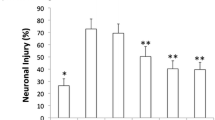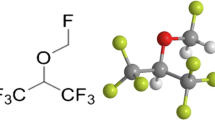Abstract
Several volatile anesthetics have presented neuroprotective functions in ischemic injury. This study investigates the effect of desflurane (Des) on neurons following oxygen–glucose deprivation (OGD) challenge and explores the underpinning mechanism. Mouse neurons HT22 were subjected to OGD, which significantly reduced cell viability, increased lactate dehydrogenase release, and promoted cell apoptosis. In addition, the OGD condition increased oxidative stress in HT22 cells, as manifested by increased ROS and MDA contents, decreased SOD activity and GSH/GSSG ratio, and reduced nuclear protein level of Nrf2. Notably, the oxidative stress and neuronal apoptosis were substantially blocked by Des treatment. Bioinformatics suggested potassium voltage-gated channel subfamily A member 1 (Kcna1) as a target of Des. Indeed, the Kcna1 expression in HT22 cells was decreased by OGD but restored by Des treatment. Artificial knockdown of Kcna1 negated the neuroprotective effects of Des. By upregulating Kcna1, Des activated the Kv1.1 channel, therefore enhancing K+ currents and inducing neuronal repolarization. Pharmacological inhibition of the Kv1.1 channel reversed the protective effects of Des against OGD-induced injury. Collectively, this study demonstrates that Des improves electrical activity of neurons and alleviates OGD-induced neuronal injury by activating the Kcna1-dependent Kv1.1 channel.






Similar content being viewed by others
Data availability
The datasets generated during and/or analyzed during the current study are available from the corresponding author on reasonable request.
References
Abbott GW (2006) Molecular mechanisms of cardiac voltage-gated potassium channelopathies. Curr Pharm Des 12:3631–3644. https://doi.org/10.2174/138161206778522065
Almeida A, Delgado-Esteban M, Bolanos JP, Medina JM (2002) Oxygen and glucose deprivation induces mitochondrial dysfunction and oxidative stress in neurones but not in astrocytes in primary culture. J Neurochem 81:207–217. https://doi.org/10.1046/j.1471-4159.2002.00827.x
Begum R, Bakiri Y, Volynski KE, Kullmann DM (2016) Action potential broadening in a presynaptic channelopathy. Nat Commun 7:12102. https://doi.org/10.1038/ncomms12102
Bhat MA, Esmaeili A, Neumann E, Balakrishnan K, Benke D (2022) Targeting the interaction of GABA(B) receptors with CHOP after an ischemic insult restores receptor expression and inhibits progressive neuronal death. Front Pharmacol 13:870861. https://doi.org/10.3389/fphar.2022.870861
Brioni JD, Varughese S, Ahmed R, Bein B (2017) A clinical review of inhalation anesthesia with sevoflurane: from early research to emerging topics. J Anesth 31:764–778. https://doi.org/10.1007/s00540-017-2375-6
Cai M et al (2021) Sevoflurane preconditioning protects experimental ischemic stroke by enhancing anti-inflammatory microglia/macrophages phenotype polarization through GSK-3beta/Nrf2 pathway. CNS Neurosci Ther 27:1348–1365. https://doi.org/10.1111/cns.13715
Chen X et al (2018) Neonatal exposure to low-dose (1.2%) sevoflurane increases rats’ hippocampal neurogenesis and synaptic plasticity in later life. Neurotox Res 34:188–197. https://doi.org/10.1007/s12640-018-9877-3
Chen C, Zuo J, Zhang H (2022a) Sevoflurane post-treatment mitigates oxygen-glucose deprivationinduced pyroptosis of hippocampal neurons by regulating the Mafb/DUSP14 axis. Curr Neurovasc Res 19:245–254. https://doi.org/10.2174/1567202619666220802104426
Chen X, Zhang J, Wang K (2022b) Inhibition of intracellular proton-sensitive Ca(2+)-permeable TRPV3 channels protects against ischemic brain injury. Acta Pharm Sin B 12:2330–2347. https://doi.org/10.1016/j.apsb.2022.01.001
Cheng A, Lu Y, Huang Q, Zuo Z (2019) Attenuating oxygen-glucose deprivation-caused autophagosome accumulation may be involved in sevoflurane postconditioning-induced protection in human neuron-like cells. Eur J Pharmacol 849:84–95. https://doi.org/10.1016/j.ejphar.2019.01.051
Deng J et al (2014) Neuroprotective gases–fantasy or reality for clinical use? Prog Neurobiol 115:210–245. https://doi.org/10.1016/j.pneurobio.2014.01.001
Diprose WK et al (2021) Intravenous propofol versus volatile anesthetics for stroke endovascular thrombectomy. J Neurosurg Anesthesiol 33:39–43. https://doi.org/10.1097/ANA.0000000000000639
Friederich P, Benzenberg D, Trellakis S, Urban BW (2001) Interaction of volatile anesthetics with human Kv channels in relation to clinical concentrations. Anesthesiology 95:954–958. https://doi.org/10.1097/00000542-200110000-00026
Gera N, Yang A, Holtzman TS, Lee SX, Wong ET, Swanson KD (2015) Tumor treating fields perturb the localization of septins and cause aberrant mitotic exit. PLoS ONE 10:e0125269. https://doi.org/10.1371/journal.pone.0125269
Gouix E, Buisson A, Nieoullon A, Kerkerian-Le Goff L, Tauskela JS, Blondeau N, Had-Aissouni L (2014) Oxygen glucose deprivation-induced astrocyte dysfunction provokes neuronal death through oxidative stress. Pharmacol Res 87:8–17. https://doi.org/10.1016/j.phrs.2014.06.002
Haelewyn B, Yvon A, Hanouz JL, MacKenzie ET, Ducouret P, Gerard JL, Roussel S (2003) Desflurane affords greater protection than halothane against focal cerebral ischaemia in the rat. Br J Anaesth 91:390–396. https://doi.org/10.1093/bja/aeg186
Hao L, Zou Z, Tian H, Zhang Y, Zhou H, Liu L (2014) Stem cell-based therapies for ischemic stroke. Biomed Res Int 2014:468748. https://doi.org/10.1155/2014/468748
Harris SA, Harris EA (2018) Molecular mechanisms for herpes simplex virus type 1 pathogenesis in Alzheimer’s disease. Front Aging Neurosci 10:48. https://doi.org/10.3389/fnagi.2018.00048
Hudetz AG, Pillay S, Wang S, Lee H (2020) Desflurane anesthesia alters cortical layer-specific hierarchical interactions in rat cerebral cortex. Anesthesiology 132:1080–1090. https://doi.org/10.1097/ALN.0000000000003179
Inada Y, Funai Y, Yamasaki H, Mori T, Nishikawa K (2020) Effects of sevoflurane and desflurane on the nociceptive responses of substantia gelatinosa neurons in the rat spinal cord dorsal horn: an in vivo patch-clamp analysis. Mol Pain 16:1744806920903149. https://doi.org/10.1177/1744806920903149
Katan M, Luft A (2018) Global burden of stroke. Semin Neurol 38:208–211. https://doi.org/10.1055/s-0038-1649503
Khatibi NH et al (2011) Isoflurane posttreatment reduces brain injury after an intracerebral hemorrhagic stroke in mice. Anesth Analg 113:343–348. https://doi.org/10.1213/ANE.0b013e31821f9524
Kim EJ, Kim SY, Lee JH, Kim JM, Kim JS, Byun JI, Koo BN (2015) Effect of isoflurane post-treatment on tPA-exaggerated brain injury in a rat ischemic stroke model. Korean J Anesthesiol 68:281–286. https://doi.org/10.4097/kjae.2015.68.3.281
Kumar S, Singh PR, Srivastava VK, Khan MP, Singh MK, Shyam R (2023) Recovery and post-operative analgesic efficacy from fentanyl-versus dexmedetomidine-based anesthesia in head and neck cancer surgery: a prospective comparative trial. Natl J Maxillofac Surg 14:130–135. https://doi.org/10.4103/njms.njms_3_22
Lakhan SE, Kirchgessner A, Hofer M (2009) Inflammatory mechanisms in ischemic stroke: therapeutic approaches. J Transl Med 7:97. https://doi.org/10.1186/1479-5876-7-97
Li M, Peng J, Wang MD, Song YL, Mei YW, Fang Y (2014) Passive movement improves the learning and memory function of rats with cerebral infarction by inhibiting neuron cell apoptosis. Mol Neurobiol 49:216–221. https://doi.org/10.1007/s12035-013-8512-9
Lin D, Li G, Zuo Z (2011) Volatile anesthetic post-treatment induces protection via inhibition of glycogen synthase kinase 3beta in human neuron-like cells. Neuroscience 179:73–79. https://doi.org/10.1016/j.neuroscience.2011.01.055
Lioudyno MI et al (2013) Shaker-related potassium channels in the central medial nucleus of the thalamus are important molecular targets for arousal suppression by volatile general anesthetics. J Neurosci 33:16310–16322. https://doi.org/10.1523/JNEUROSCI.0344-13.2013
Malhotra P, Mychaskiw G, Rai A (2013) Desflurane versus opioid anesthesia for cardiac shunt procedures in infants with cyantoic congential heart disease. Anesth Pain Med 3:191–197. https://doi.org/10.5812/aapm.9511
Mao R, Zong N, Hu Y, Chen Y, Xu Y (2022) Neuronal death mechanisms and therapeutic strategy in ischemic stroke. Neurosci Bull 38:1229–1247. https://doi.org/10.1007/s12264-022-00859-0
Mapelli J et al (2015) The effect of desflurane on neuronal communication at a central synapse. PLoS ONE 10:e0123534. https://doi.org/10.1371/journal.pone.0123534
Mattson MP, Cheng B, Davis D, Bryant K, Lieberburg I, Rydel RE (1992) beta-Amyloid peptides destabilize calcium homeostasis and render human cortical neurons vulnerable to excitotoxicity. J Neurosci 12:376–389. https://doi.org/10.1523/JNEUROSCI.12-02-00376.1992
Miller AP, Navar AM, Roubin GS, Oparil S (2016) Cardiovascular care for older adults: hypertension and stroke in the older adult. J Geriatr Cardiol 13:373–379. https://doi.org/10.11909/j.issn.1671-5411.2016.05.001
Morone G, Pichiorri F (2023) Post-stroke rehabilitation: challenges and new perspectives. J Clin Med 12. https://doi.org/10.3390/jcm12020550
Pardo LA (2004) Voltage-gated potassium channels in cell proliferation. Physiology (bethesda) 19:285–292. https://doi.org/10.1152/physiol.00011.2004
Paulhus K, Glasscock E (2023) Novel genetic variants expand the functional, molecular, and pathological diversity of KCNA1 channelopathy. Int J Mol Sci 24. https://doi.org/10.3390/ijms24108826
Peng S et al (2011) Sevoflurane postconditioning ameliorates oxygen-glucose deprivation-reperfusion injury in the rat hippocampus. CNS Neurosci Ther 17:605–611. https://doi.org/10.1111/j.1755-5949.2010.00193.x
Raub D et al (2021) Effects of volatile anesthetics on postoperative ischemic stroke incidence. J Am Heart Assoc 10:e018952. https://doi.org/10.1161/JAHA.120.018952
Robinson T, Zaheer Z, Mistri AK (2011) Thrombolysis in acute ischaemic stroke: an update. Ther Adv Chronic Dis 2:119–131. https://doi.org/10.1177/2040622310394032
Schallner N, Ulbrich F, Engelstaedter H, Biermann J, Auwaerter V, Loop T, Goebel U (2014) Isoflurane but not sevoflurane or desflurane aggravates injury to neurons in vitro and in vivo via p75NTR-NF-kB activation. Anesth Analg 119:1429–1441. https://doi.org/10.1213/ANE.0000000000000488
Schifilliti D, Grasso G, Conti A, Fodale V (2010) Anaesthetic-related neuroprotection: intravenous or inhalational agents? CNS Drugs 24:893–907. https://doi.org/10.2165/11584760-000000000-00000
Servettini I et al. (2023) An activator of voltage-gated K(+) channels Kv1.1 as a therapeutic candidate for episodic ataxia type 1. Proc Natl Acad Sci USA 120:e2207978120. https://doi.org/10.1073/pnas.2207978120
Shah NH, Aizenman E (2014) Voltage-gated potassium channels at the crossroads of neuronal function, ischemic tolerance, and neurodegeneration. Transl Stroke Res 5:38–58. https://doi.org/10.1007/s12975-013-0297-7
Shpetko YY, Filippenkov IB, Denisova AE, Stavchansky VV, Gubsky LV, Limborska SA, Dergunova LV (2023) Isoflurane anesthesia’s impact on gene expression patterns of rat brains in an ischemic stroke model. Genes (Basel) 14. https://doi.org/10.3390/genes14071448
Speake T, Kibble JD, Brown PD (2004) Kv1.1 and Kv1.3 channels contribute to the delayed-rectifying K+ conductance in rat choroid plexus epithelial cells. Am J Physiol Cell Physiol 286:C611-620. https://doi.org/10.1152/ajpcell.00292.2003
Tuo QZ, Zhang ST, Lei P (2022) Mechanisms of neuronal cell death in ischemic stroke and their therapeutic implications. Med Res Rev 42:259–305. https://doi.org/10.1002/med.21817
Vizuete JA, Pillay S, Diba K, Ropella KM, Hudetz AG (2012) Monosynaptic functional connectivity in cerebral cortex during wakefulness and under graded levels of anesthesia. Front Integr Neurosci 6:90. https://doi.org/10.3389/fnint.2012.00090
Wang H, Li P, Xu N, Zhu L, Cai M, Yu W, Gao Y (2016) Paradigms and mechanisms of inhalational anesthetics mediated neuroprotection against cerebral ischemic stroke. Med Gas Res 6:194–205. https://doi.org/10.4103/2045-9912.196901
Wang L, Lu SR, Wen J (2017) Recent advances on neuromorphic systems using phase-change materials. Nanoscale Res Lett 12:347. https://doi.org/10.1186/s11671-017-2114-9
Wang S, Li Y, Wei J, Li P, Yang Q (2018) Sevoflurane preconditioning induces tolerance to brain ischemia partially via inhibiting thioredoxin-1 nitration. BMC Anesthesiol 18:171. https://doi.org/10.1186/s12871-018-0636-z
Wang X et al (2019) TRPV1 translocated to astrocytic membrane to promote migration and inflammatory infiltration thus promotes epilepsy after hypoxic ischemia in immature brain. J Neuroinflammation 16:214. https://doi.org/10.1186/s12974-019-1618-x
Wonderlin WF, Strobl JS (1996) Potassium channels, proliferation and G1 progression. J Membr Biol 154:91–107. https://doi.org/10.1007/s002329900135
Yang F (2022) A gating mechanism of K2P channels by their selectivity filter. J Mol Cell Biol 14. https://doi.org/10.1093/jmcb/mjac018
Yi BA, Minor DL Jr, Lin YF, Jan YN, Jan LY (2001) Controlling potassium channel activities: interplay between the membrane and intracellular factors. Proc Natl Acad Sci U S A 98:11016–11023. https://doi.org/10.1073/pnas.191351798
Zhong W, Huang Q, Zeng L, Hu Z, Tang X (2019) Caveolin-1 and MLRs: a potential target for neuronal growth and neuroplasticity after ischemic stroke. Int J Med Sci 16:1492–1503. https://doi.org/10.7150/ijms.35158
Zhou Y, Lekic T, Fathali N, Ostrowski RP, Martin RD, Tang J, Zhang JH (2010) Isoflurane posttreatment reduces neonatal hypoxic-ischemic brain injury in rats by the sphingosine-1-phosphate/phosphatidylinositol-3-kinase/Akt pathway. Stroke 41:1521–1527. https://doi.org/10.1161/STROKEAHA.110.583757
Acknowledgements
None.
Funding
None.
Author information
Authors and Affiliations
Contributions
XLN performed experiments and wrote the manuscript; XYY performed experiments and collected data; QQY performed experiments and statistical analysis; XHS conceived the idea and designed the study; SS designed and supervised the study, and revised the manuscript. All authors have read and approved the manuscript.
Corresponding author
Ethics declarations
Conflict of interest
The authors declare that there is no confict of interest regarding the publication of this paper.
Additional information
Communicated by Sreedharan Sajikumar.
Publisher's Note
Springer Nature remains neutral with regard to jurisdictional claims in published maps and institutional affiliations.
Supplementary Information
Below is the link to the electronic supplementary material.
Rights and permissions
Springer Nature or its licensor (e.g. a society or other partner) holds exclusive rights to this article under a publishing agreement with the author(s) or other rightsholder(s); author self-archiving of the accepted manuscript version of this article is solely governed by the terms of such publishing agreement and applicable law.
About this article
Cite this article
Ni, X., Yu, X., Ye, Q. et al. Desflurane improves electrical activity of neurons and alleviates oxygen–glucose deprivation-induced neuronal injury by activating the Kcna1-dependent Kv1.1 channel. Exp Brain Res 242, 477–490 (2024). https://doi.org/10.1007/s00221-023-06764-w
Received:
Accepted:
Published:
Issue Date:
DOI: https://doi.org/10.1007/s00221-023-06764-w




